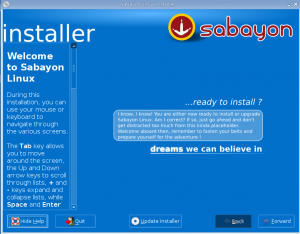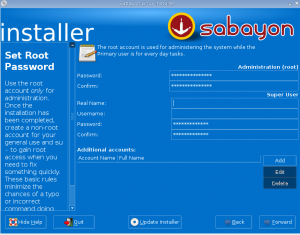Review: Sabayon 3.5 Pod
By EricMesa
- 9 minutes read - 1732 wordsSince both Gentoo and Sabayon were included on this Linux Format DVD, I decided I would first try and install Gentoo and then Sabayon and compare how easy the installations were since Sabayon is a derivative distro from Gentoo. As you know, I was unable to get a working installation from the LiveCD of Gentoo. If this was the case for most people, then the fact that they will no longer produce one is a good riddance. Sabayon, like most of the “modern” distros (or at least Ubuntu and Fedora), display a loading screen instead of the “ok” messages.
The Sabayon slogan unfrotunately reminds me a bit too much of the current presidential campaign in the USA. I do, however, like the graphics - soft blues and elegant simplicity. Here’s the default desktop on the LiveCD.
There are two things I don’t like here. First of all, the mouse pointer is HUGE. But second, I’m not a huge fan of distros radically changing the defaults in the desktops. Xfce should look more like CDE than KDE. Still, only minor issues. On the positive side, unlike with Gentoo, the liveCD has built in audio players so I was able to test and confirm that audio should work as I have it set up in the virtual machine. Here I test that the audio works by listening to the Severed Fifth intro.
The Sabayon LiveCD also does a better job of giving the prospective Linux user an idea of what programs they might use. Included are GIMP, Audacious, Mplayer, RealPlayer 10, Firefox, Pidgin, Abiword and Gnumeric. Ok, so let’s get installing and see if it’s easier.
The installation program is quite blue!
I thought it looked very familiar and today I found out the Sabayon project is using Anaconda (which is what Fedora uses for installs) so that’s why it looked so familier. First step is to select my language (english). Second step is the keyboard - us english. Next I had to choose whether I wanted EEE PC Sabayon, Xfce, or basically just a commandline system. I chose Xfce.
Then came package selections. They appeared to be limited to what was included on the DVD because clicking on details didn’t allow me to select extra things. I just left it with the defaults. Next it was time to choose individual packages. It was very unclear where the check-boxes were. But if you clicked in the right place it gave you the option to remove packages. I removed Compiz and left everything the same. If you double-click on a package you get a very detailed description of the package.
Next was choosing which services to enable. I left this at the defaults.
I left partitions at automatic partition. Then came the grub installation screen and it was no more complicated than in other distros. This was followed by the ethernet settings. Again - it was pretty standard - not more complicated nor less complicated than Ubuntu or Fedora. Then it was time to set the timezone and the users. I like that root and the normal user are on one screen to help show the computer user that these are two separate accounts.
I love that, unlike with Gentoo it double-checks the user’s password. Then the installation began.
Apparently, during the installation they show desktops of Sabayon users.
So the installation began…and finished about 20 minutes later. Not bad! So I reboot the VM. It loads up that dreams we can believe in screen again. And I end up at a very nice looking GDM login screen:
And I find myself at a desktop that looks exactly the same as before with exactly the same selection of programs. And the sound and internet work!!
So, there you go, it’s easier to install than Gentoo and everything works after installation as well as it did in the LiveCD. Now, I notice that I’m not getting any notices that my packages are out of date. It is possible, of course, that my packages are not out of date. But I find that hard to believe - after all, they probably started work on this magazine DVD 2 or more months ago. Perhaps I need to first use the package manager. So I launch the Spritz Package Manager.
Ok…so maybe I AM up to date? On the repository page, I clicked refresh and that started downloading the repository database. Perhaps I do need updates….I’ll find out in a few minutes. I think, if it wasn’t going to happen automatically, it should have told me to do that when I logged in for the first time. Overall, I really like the Spritz Package Manager. It’s very well-polished. I think the closest thing I’ve seen to this that’s this good would be Mandriva’s package management. This looks nicer. Now it started getting security advisories. It earlier said it didn’t have any and I couldn’t believe that. Now, this is more like it. I have to update everything that’s installed.
Now, one place where it looses points vs Mandriva, Fedora with package-kit, and Ubuntu is in the categories of the packages. This is where I would go to install packages by categories:
It’s not hard at all to figure out what games-board means. But it’s uglier and not quite as elegant as the rest of Sabayon. I decide to install Blender to see how easy it is to do. (not that I can actually expect for it to work well in a virtual machine) It takes a little while to search through the packages. And it finds 2.46. It’s one revision behind, but then again Fedora likes to push the edge. Ubuntu and FreeBSD are also not yet at 2.47.
I also decide to process all the updates. Now it wasn’t 100% clear what to do, but I quickly figured it out. All the packages I was going to install were put into a queue. So I will click on process queue.
It was taking a while to download. It grabbed a bunch of tbz2 files. It looked like it was probably going to do like FreeBSD and then it was going to compile and install the files. I’m off to bed (since I’m “live-blogging” this) and I’ll see what’s going on when I wake up. When I woke up it was on package 87/179. I’ll leave it downloading while I’m at work today. Three hours later (I had to come home early for something) it was on 126. 8 hours later it’s still not done. It’s on 127/179. Does it only fetch packages if I’m watching? Now it’s Tuesday and I started this on Sunday. It’s on 160/179. This is really, really slow…. I wonder if there’s a mirror list of faster mirrors and the default mirror just sucks. Got home and 170/179. I have a very fast broadband connection and usually a 500 MB file takes 30 minutes to and hour to download. So I think it was probably a mirror issue. It finished after a little while and then began installation.
Finally, on Wednesday, it finished. That took waaaaay too long. At least everything worked while that was happening. However, since I installed it into virtualbox, it could be that it’s not getting enough processor power to build the packages quickly enough. There were a lot of messages going by while packages were built letting me know that this package or that one needed some post-configuration like me changing a config file. I wonder if there’s somewhere I can see that after installation is done. Spritz then informed me that everything was done. But then it became unresponsive. I rebooted so I could get into the new kernel, xfce, etc
So I was now using Xfce 4.4.2. Blender was installed and it surprisingly worked from within the VirtualBox! Firefox was now 3.0.1. So it appears to be just as up-to-date package-wise as all the other major distros - Fedora, Ubuntu, etc Interestingly, Spritz now has a banner ad. Well, if that’s how they pay the server bills, then that’s ok by me. The icons were also slightly different.
So what’s the verdict? On the one hand, Sabayon beat my first try at installing Gentoo via LiveC D. But on the other hand, it took basically 3 days to update the few packages that were installed. Again, that might just be a VM or mirror thing, but that definitely is horrible. Second, ever since the packages finished installing I’ve been trying to load up spritz to see which versions of other programs are available, but spritz keeps freezing. And when it hadn’t frozen and I attempted to update the sources, it crashed. So I’m going to say that my final verdit is as follows:
Visual Appeal: Great, inviting - something about the background, bootup background and theme they’ve chosen just looks right
Ease of use (distro installation): Easy as any of the easy-to-use distros - especially Fedora since it uses Anaconda
Ease of use (programs): For running programs and all that it’s about as easy as Ubuntu.
Ease of use (initial configuration): Pretty good. Audio works and it even appears to have flash preinstalled.
Ease of use (package installation): I’d have to say that Sabayon, while easier than Gentoo, is certainly not yet ready for primetime. It’s not as easy to install programs as in Ubuntu or Fedora. For the first time user, Synaptic and PackageKit are a LOT easier to use. A lot of the choices in Spritz seemed odd or confusing to me so imagine someone who was told that Sabayon is easy enough for new users. In the end, I could never get it to work again and it complained about needing to get a new version of entropy, but I couldn’t get it since the installer was b0rked. I took a closer look at the error. It’s an absurd catch-22. When I try to download the repository I get a warning that I can’t do that because I haven’t downloaded the repository. Then Spritz appears to lock up. I have no idea if it’s doing stuff in the background.
In the end I’d say - first get used to Linux on Ubuntu, Mandriva, openSUSE, or Fedora. After that, check out Debian. Then you’re ready for Sabayon and it would probably be a good stepping-stone to trying out Gentoo, Slackware, and other more involved distros.


















